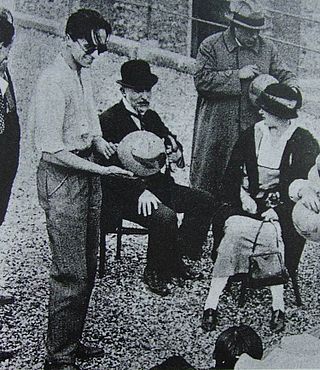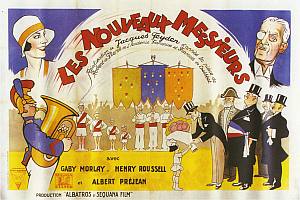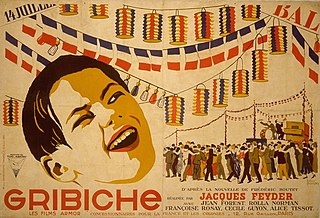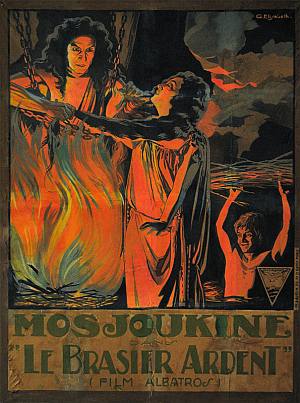Related Research Articles

René Clair, born René-Lucien Chomette, was a French filmmaker and writer. He first established his reputation in the 1920s as a director of silent films in which comedy was often mingled with fantasy. He went on to make some of the most innovative early sound films in France, before going abroad to work in the UK and USA for more than a decade. Returning to France after World War II, he continued to make films that were characterised by their elegance and wit, often presenting a nostalgic view of French life in earlier years. He was elected to the Académie Française in 1960. Clair's best known films include Un chapeau de paille d'Italie, Sous les toits de Paris, Le Million (1931), À nous la liberté (1931), I Married a Witch (1942), and And Then There Were None (1945).

Ivan Ilyich Mozzhukhin, usually billed using the French transliteration Ivan Mosjoukine, was a Russian silent film actor.
Lazare Meerson (1900–1938) was a French cinema art director. After emigrating from Soviet Russia in the early 1920s, he worked on French films of the late silent cinema and the early 1930s, particularly those directed by René Clair and Jacques Feyder. He worked in England during the last two years of his life. He had great influence on film set design in France in the years before World War II.

The Ballets Russes was an itinerant ballet company begun in Paris that performed between 1909 and 1929 throughout Europe and on tours to North and South America. The company never performed in Russia, where the Revolution disrupted society. After its initial Paris season, the company had no formal ties there.

Marcel L'Herbier was a French filmmaker who achieved prominence as an avant-garde theorist and imaginative practitioner with a series of silent films in the 1920s. His career as a director continued until the 1950s and he made more than 40 feature films in total. During the 1950s and 1960s, he worked on cultural programmes for French television. He also fulfilled many administrative roles in the French film industry, and he was the founder and the first President of the French film school Institut des hautes études cinématographiques (IDHEC).
Dimitri Kirsanoff was a Russian-French early film-maker working in France, sometimes considered part of the French Impressionist movement in film. He is known for some poetic silent films which he made independently, especially the medium-length Ménilmontant, but he was less successful with commercial films in the sound era.

The Italian Straw Hat is a 1928 French silent film comedy written and directed by René Clair, in his feature debut, based on the 1851 play Un chapeau de paille d'Italie, by Eugène Marin Labiche and Marc-Michel.

Faces of Children is a 1925 French-Swiss silent film directed by Jacques Feyder. It tells the story of a young boy whose mother has died and the resentments which develop when his father remarries. It was a notable example of film realism in the silent era, and its psychological drama was integrated with the natural landscapes of Switzerland where much of the film was made on location.

Feu Mathias Pascal is a 1925 French silent film written and directed by Marcel L'Herbier. It was the first film adaptation of Luigi Pirandello's novel Il fu Mattia Pascal.
Raphaël Millet is a French writer, critic, producer and director of cinema and television, as well as an organiser and programmer of photographic and cultural events.

Les Nouveaux Messieurs is a 1929 French silent film directed by Jacques Feyder. It is a satirical comedy, whose initial release in France was delayed for several months because of objections to its portrayal of the French parliament.
Fédote Bourgasoff was a Russian Empire-born French cinematographer.

Jean Douchet was a French film director, historian, film critic and teacher who began his career in the early 1950s at Gazette du Cinéma and Cahiers du cinéma with members of the future French New Wave.

Alexandre Kamenka was a Russian-born French film producer. He was born the son of Boris Kamenka in Odessa, now in Ukraine. At that time the city was part of the Russian Empire. He fled following the Russian Revolution and went to France where he established the production company Films Albatros. A number of other Russian exiles were involved with the company.

Le Lion des Mogols(The Lion of the Moguls) is a 1924 French drama film directed by Jean Epstein. It is the first film that he directed for the Films Albatros production company.
La Maison du mystère is a French silent serial film directed by Alexandre Volkoff for the Albatros film company. It was made during 1921 and 1922 and was first shown in 1923. It was co-written by and starred Ivan Mosjoukine.

Gribiche is a 1926 French silent film directed by Jacques Feyder based on the eponymous short story by writer Frédéric Boutet.

The Orderly is a 1933 French drama film directed by Victor Tourjansky and starring Marcelle Chantal, Jean Worms and Fernandel. It is based on Guy de Maupassant's story L'ordonnance. Tourjanski had already filmed the same story in 1921. It was shot at the Joinville Studios of Pathé-Natan in Paris. The film's sets were designed by the art director Serge Piménoff. It was voted amongst the most popular films of the year by readers of the Pour Vous magazine.

Nicolas Koline (1878–1973) was a Russian stage and film actor. He established himself in Russia as a stage performer with the Moscow Art Theatre. He emigrated from Russia after the October Revolution of 1917 and came to France with La Chauve-Souris cabaret run by Nikita Balieff. In Paris he then joined Joseph Ermolieff's film company at Montreuil. He appeared in numerous French and German films during his career, initially often as a leading player during the silent era and later in supporting roles.

Le Brasier ardent is a 1923 French film directed by Ivan Mosjoukine. It combines elements of comedy, mystery, romance and psychological drama. The title has been variously translated into English as The Blazing Inferno, The Burning Crucible, The Burning Brazier, The Burning Cauldron, and Burning Embers.
References
- ↑ Charles Drazin. The Faber Book of French Cinema. London: Faber & Faber, 2011. p.44.
- ↑ Richard Abel, French Cinema: the First Wave, 1915-1929. Princeton, NJ: Princeton University Press, 1984. p. 45.
- ↑ "Le cinéma russe en exil: l'aventure des Films Albatros": online exhibition at Cinémathèque française (2009). [Retrieved 26 December 2015. In French.]
- ↑ The French Cinema Book, edited by Michael Temple and Michael Witt. London: British Film Institute, 2004. p. 31.
- ↑ Dictionnaire du cinéma français, sous la direction de Jean-Loup Passek. Paris: Larousse, 1987. p. 253.
- ↑ Richard Abel, French Cinema: the First Wave, 1915-1929. Princeton, NJ: Princeton University Press, 1984. p. 24.
- 1 2 Claude Beylie, Une histoire du cinéma français. Paris: Larousse, 2005. p. 96.
- ↑ Dudley Andrew, Mists of Regret. Princeton, NJ: Princeton University Press, 1995. p. 178.